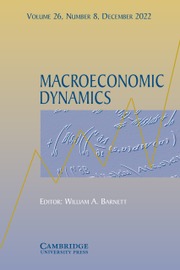No CrossRef data available.
Article contents
Inflation, inequality, and welfare in a competitive search model
Published online by Cambridge University Press: 26 May 2025
Abstract
We study long-run inflation in a competitive-search model with heterogeneous agents. Under competitive search, individuals’ matching-probability (extensive) margins trade off against quantity (intensive) margins. With money and unfettered market participation, these trade-offs depend on inflation and individuals’ heterogeneous money holdings. We find that welfare falls as inflation increases. However, money-holdings inequality is not monotonic in inflation. As inflation rises, liquid-wealth inequality first falls. For sufficiently high inflation, the overall extensive-margin effect dominates the intensive margin, and liquid-wealth inequality rises. The model also poses a new computational challenge to which we propose a novel solution method.
Information
- Type
- Articles
- Information
- Copyright
- © The Author(s), 2025. Published by Cambridge University Press

